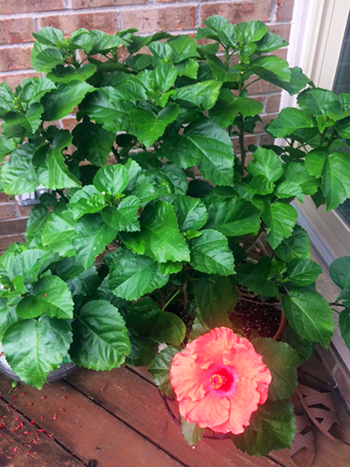Plant Care
Wilting Leaves
Fall and winter, when temperatures are falling, are cold and flu season for humans. Hibiscus have their own equivalent of colds and flu - wilt diseases. When soil is cold and damp, and air temperatures are cold all around, hibiscus can get sick, much like humans. Fortunately, it's easy to diagnose a sick hibiscus quickly. The plant simply starts to wilt, and when you feel the soil, it is wet. Sadly too many people wait to deal with this problem, and a winter cold can turn into catastrophic pneumonia in a matter of a few days. If you let a wilted hibiscus go, you can lose the plant within a week or two! At the first sign of the first hint of wilting, it's important to rush in and nurse the plant back to health.
 A hibiscus in the early stages of wilt. Some leaves are still crisp, but others are partially wilted. It's time to act NOW! |
The treatment for a wilting hibiscus is not difficult. It's almost identical to the treatment for any other kind of hibiscus stress. Anyone can do it quickly and easily. Just keep these directions handy, and use them at the very first sign of wilting on any of your plants:
Directions for Saving a Wilting Hibiscus
- Get your hibiscus out of the sun quickly!
- If it's in a pot, move it to a place that has bright shade, but no direct sunlight at all.
- If it's in the ground, try to create some shade for it with a tarp, umbrella, or tree branch.
- If it's in the house, move it away from any sunny windows.
- If possible, try to move it to a place that is warm and protected from the wind and nighttime cold.
- Fill some kind of spray bottle with water and mist your plant really well. Try to wet all the leaves well, but avoid misting the soil if it is already wet.
- Check the leaves quickly.
- If any leaves are very yellow, remove them so the plant doesn't have to waste energy dropping them off.
- Leave all green leaves on the plant, even if they are wilted. Green leaves can still photosynthesize, and may spring back up to health.
- Do NOT transplant! Leave in the original pots or spot in the ground.
- Do NOT prune or cut in any way!
- Do NOT water until the soil is a bit dry on the surface, then water only a little bit:
- If you have SuperNova Growth Enhancer, use a double dose of it in a small amount of water, or
- If you have HVH Houseplant Formula, use a normal dose of it in a small amount of water.
- If you don't have either of these emergency products, then use ONLY PLAIN WATER.
- Do NOT use any other products or fertilizers! Fertilizer creates more stress for a wilting plant.
- Mist your hibiscus every day. Try to really wet down all sides of all the leaves. The extra hydration will take some stress off the roots while the plant recuperates. Continue misting daily until you see active growth.
 This hibiscus bounced back quickly! It is crisp and healthy after only 2 weeks of treatment. Other hibiscus will take 2-3 months, so be patient! |
Continue this treatment until the leaves crisp back up and you see new active green growth for at least 2 weeks. Then slowly start inching your hibiscus back toward the sun, and gradually start adding regular fertilizer into the plant water. If you see any signs of wilt return, go back to the wilt instructions again.
You will need to be patient. Some hibiscus will bounce back from the early stages of wilt in 1-2 weeks, but if often takes longer. It took us 3 full months to cure one of our most beloved hibiscus plants that got caught in a winter freeze! But after those 3 months, the plant went back to the greenhouse where it is now bigger and healthier than ever. So this does work if you just keep following the protocol patiently until your sick plant fully recovers.
What if Only a Branch or Two are Wilted?
 A hibiscus with only 2 tiny wilted branches. Take this wilt seriously! It can spread rapidly and kill the whole plant! |
If you see only a branch or two that are wilted, you will need to figure out what is going on. If the tips of the branches are black, then this is called dieback and it is safe to just cut off the sick branches. But if the tips are green, as in the photo at right, then this is early stages of Wilt Disease, and you need to do the full treatment above very, very quickly! This kind of wilt can spread overnight and quickly kill your whole plant. So take it just as seriously as you would take a whole plant that is wilted.
Remember, the key to successfully saving a hibiscus with wilt disease is speed! If you're running out the door to go to work and spot a sick plant, just pull it quickly out of the sun. Or throw an umbrella over it if it's in the ground outside. Protecting it from the sun will hold it for a few hours while you work, then you can complete the rest of the treatment when you get home. Most hibiscus will respond quickly if you treat quickly, so keep your eye out for wilting as cold weather comes, and be prepared with either SuperNova Growth Enhancer or HVH Houseplant Formula on hand as part of your hibiscus first aid kit.